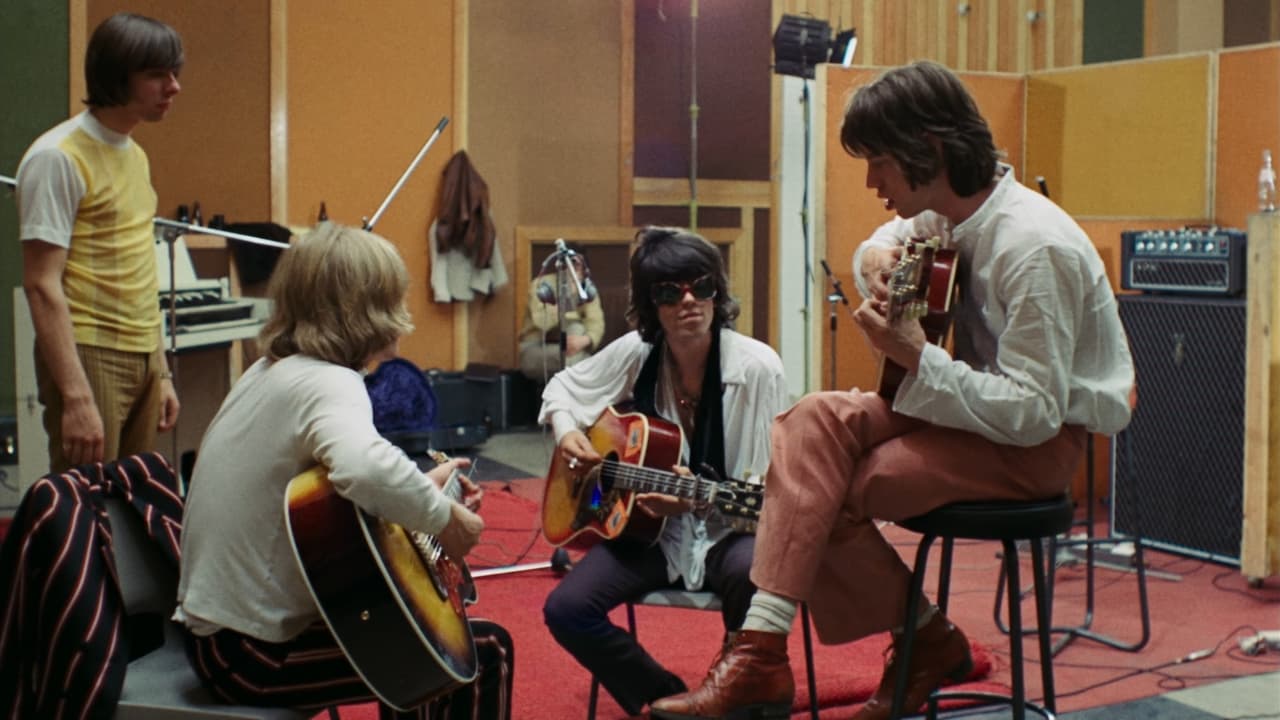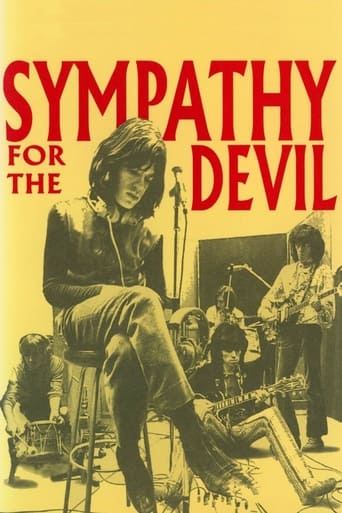

Has a film ever combined one theme of such wide popular appeal with another that will interest only a small crowd and simply baffle that big popular audience? Jean-Luc Godard's SYMPATHY FOR THE DEVIL would delight one set of viewers and infuriate another. How does one even give a star rating to this? In May 1968, Jean-Luc Godard was permitted to film the Rolling Stones over several days in a London studio as they gradually fleshed out their now classic song "Sympathy for the Devil", and so one might expect simply a documentary about a rock band's creative process. However, over the last year Godard had broken ties with conventional cinema (even in its zany French New Wave form) and was now interested in using film to agitate for the Maoist philosophy that he had latched onto as the Zeitgeist for this era. Consequently, hardly have we seen the Stones at work before Godard cuts to completely different footage centered around the reading of strident political texts. Over the course of the film we repeatedly go back and forth between the Rolling Stones in the studio and political shots: Black Panthers sitting around a junkyard and advocating revolution, a woman spraypainting Maoist slogans over London walls, a comic book shop as a metaphor for American imperialism, etc.Even if the juxtaposition is jarring and indeed rather silly, the Rolling Stones portion of the film is satisfying for fans of this music. The viewer gets a sense of how the song "Sympathy for the Devil" went from merely a product of Jagger's imagination that he has to teach Keith Richards to ultimately the ample rendition with conga and backing-vocals that was finally released. Probably unbeknownst to Godard himself at the time, the film also serves as a portrait of Brian Jones' breakdown only about a year before his death: he's sometimes present in the studio, but he just sits in the corner, neglected by his bandmates and strumming a guitar that isn't even miked.The rest of the Stones, however, are clearly enjoying themselves. It's amusing how Jagger's English working-class accent, itself quite fake, immediately shifts to an imitation of some old American bluesman as soon as the recording of each take starts; rarely have I got such a vivid sense of how much blues meant to this generation of English youth. The last shot of the band in the film, presumably after recording wrapped on "Sympathy of the Devil", is a longish jam session. Another delight of this film for music lovers is that we can see in full colour how recording studios looked in the 1960s with the technology and sound insulation strategies of that era. (Everyone's smoking constantly, too. The place must have smelled like an ashtray).What, then, of the political bits? These would weird out anyone not familiar with Godard's earlier work of the late 1960s, but if one watches his films chronologically, then there is a clear progression from WEEKEND, his last relatively conventional film: again we see a breakdown of 1960s consumerist society depicted through militants holding guns versus prostrate figures red with (intentionally very fake) blood. Anne Wiazemsky, who had acted in Godard's immediately preceding films as a symbol of rebellious youth and now the director's second wife, appears as the personification "Eve Democracy". Unable to answer anything to her interlocutor's questions but "Yes" or "No", she mocks what Godard saw as the impotency of bourgeois representative democracy, where the people have no other way to effect political change except to vote for or against a candidate, a process that happens only every few years even as the nation is confronted by pressing challenges.Godard's politics during this time were wonky and it's hard to tell just how seriously he believed in Maoism, or whether the 38-year-old director was just trying on a fad to be closer to the youth. And yet, for viewers interested in history and especially this turbulent decade, the political scenes too hold a lot of interest. In the comic book shop segment, the camera pans slowly across the shelves, presenting a variety of pulp literature and pornography that is utterly forgotten today. Didactic as the scenes of the Black Panthers and Eve Democracy might be, even they can be appreciated as a time capsule of 1960s fashion thanks to their colourfully dressed characters.
... View MoreDon't expect this film to reveal its charms on first viewing. It is akin to a difficult piece of classical music. The first view is strictly baffling. The juxtaposition of elements is absurd, the characterisations fantastical. It marches on. You don't know where it is going. To Godard's chagrin no doubt, he creates beautiful scenes, amongst them Anne Wiazemsky's disappearance into the green wood. He provides an uninterrupted view. Historically fascinating - London with its rough edges. And the Stones at work and play with Nicky Hopkins pulling it together on the keyboards. A must see for Stonesologists and rock specialists. Political fire in the belly. Not time wasted. A sharpening experience.
... View MoreIn the 60's, having as the background the rehearsal and recording of "Sympathy for the Devil" in the classic album "Beggar's Banquet" by the revolutionary bad boy Rolling Stones Mick Jagger, Keith Richards, Charlie Watts, Bill Wyman and Brian Jones plus Marianne Faithful, Godard discloses other contemporary revolutionary and ideological movements the Black Power through the Black Panthers, the feminism, the communism, the fascism - entwined with the reading of a cheap pulp political novel divided in the chapters: "The Stones Rolling; "Outside Black Novel"; "Sight and Sound"; "All About Eve"; "The Heart of Occident"; "Inside Black Syntax"; and, "Under the Stones the Beach"."Sympathy for the Devil" is another pretentious and boring mess of the uneven director Jean-Luc Godard. The narrative and the footages are awful, but fortunately I love the Stones and "Sympathy for the Devil" and it is nice to see them in the beginning of their careers; otherwise this documentary would be unbearable. My vote is three.Title (Brazil): "Sympathy for the Devil"
... View MoreIt utterly defeats me why Godard is taken so seriously - and One Plus One is a great example of his ineptitude as both a filmmaker and an 'intellectual' polemicist. It's hard to credit that Godard actually believed all that Marxist and Maoist kant. Anyone with half a brain could work out the bankruptcy of those 'isms' and how many people they had destroyed and were continuing to destroy even as Godard was making his films supporting them. As a filmmaker, ask yourself: would you have boring voice-overs reading tedious political diatribes at your audience, and then, when you couldn't think of anything else to do, layer another voice-over to the first voice-over, which had lost its listeners after the first 100 words in any case? Brilliant, Jean-Luc! As for Godard insisting on making a film with the Rolling Stones: of course he did; wouldn't you? It was the only guarantee of getting such mindless rubbish seen in the first place: the genius of the Stones eclipsing a talentless and babbling political idiot set loose with a camera. The bookshop scene wasn't worthy of even the worst fringe theatre, and was an insult to the intelligence of even the young children who were used to play in it - as could be readily seen. Copping-out by allowing friendly critics to claim that all this artless crap was a satire on mainstream film-making is no more than a safe get-out to offer those who clearly see Godard's poverty of intellect and arrogant contempt for his audience. Ironic that Godard's one-time great friend, Truffaut, with Nuit Americain, made the best film about film-making ever, and Godard made the worst with Le Mepris! Incidentally, Godard didn't choose the Stones' track of Sympathy With the Devil. It just happened to be the track they were working on when the 'film' started shooting at Barnes Olympic Studios.
... View More